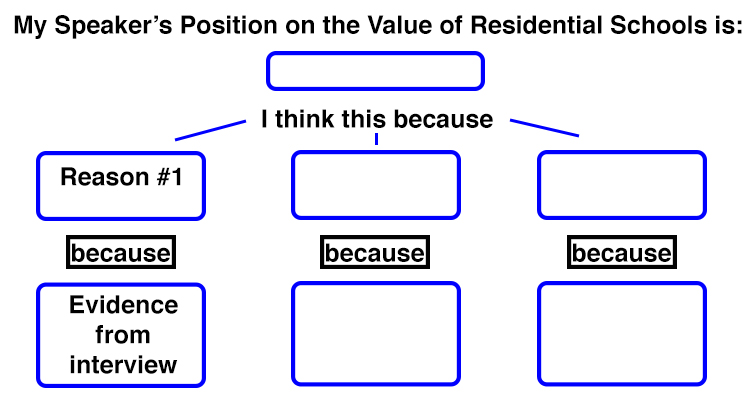Activity 1
Briefly review the terms assimilation, marginalization, accommodation, integration, homogenization and their impact on cultural stability. Why were these techniques used in the past? What kinds of real world examples do you know of?
Brainstorm with students how assimilation happens. What kinds of techniques are used and what do we risk losing with assimilation? (Traditions, language, religion, spirituality, the arts, attire, relationship to land, ideological beliefs etc.)
Pose the question to students – “To what extent can schools control culture?”
Have students create a line across the front of the room to express their opinion. One side of the line would argue that changes in schooling do not effect changes in culture, and one side would argue that changes in schooling are the main reasons for changes in culture.
Activity 2
Introduce or reintroduce students to the concept of residential schools in Canada. Show students these two videos.
Canadian Residential School Propaganda Video 1955
Residential schools leave a deadly legacy
Have students answer the following questions related to the videos:
What purpose did the creator of the videos have in making the video?
Who likely created it?
What information are they trying to convey to viewers?
What or whose perspective does the video reflect?
What concepts do we need to know to fully understand the videos?
Activity 3
Divide students into four groups. Provide each group with one of the following speaker descriptions and sound recordings.
1. First Nations Canadian who did not go to a residential school.
a. Interviewee #1
2. First Nations Canadian who did go to a residential school.
a. Interviewee #2
3. First Nations Canadian whose parents practiced Catholicism and Anglicanism.
a. Interviewee #3
4. A priest, Father Lavernce discussing First Nations participation in religion.
a. Audiograph recording 6-Father Lavernce, Shot on Both Sides, Bruised Head, and Mrs. Shot on Both Sides
As students listen to their assigned audio recording, have them fill out a position chart giving examples from the audio of why their speaker would have the view of residential schools that they have.
Activity 4
Students may use their position chart to create a parliamentary brief or commission. In this commission students will speak on behalf of the speaker they have just listened to. In the commission they must be speaking to a parliamentary board who is deciding if a sizable budget should be granted to a First Nations cultural revitalization project. Each brief must be expressing the views on residential schools and European culture in Canada that was expressed in the interview which that group listened to.
If students finish writing early, encourage them to memorize their piece prior to presentations. Students may write a briefing individually or as a group.
Activity 5
Painter de Grandmaison chose to paint First Nations in the way they really appeared, rather than have them dress up or act a certain way to fit what Europeans assumed as a correct stereotype. Ask students why he did this. (To avoid bias, to avoid hearing the position of others on how they should look etc.) Identify the perspective that de Grandmaison is bringing to his paintings, and then compare and contrast that with popular perspectives on First Nations held by Europeans at the time.
Discuss how his perspective and what he chose to paint affects what we know about First Nations culture today.
Activity 6
Students may complete a final reflection, or exit slip answering the question: What value does oral history have in cultural revitalization and why is it important to preserve such records?
Assessment:
Consider assessing student speaker position charts for validity and in depth understanding of multiple perspectives. Consider assessing student briefing through the use of a rubric to assess presentational skills and content.
